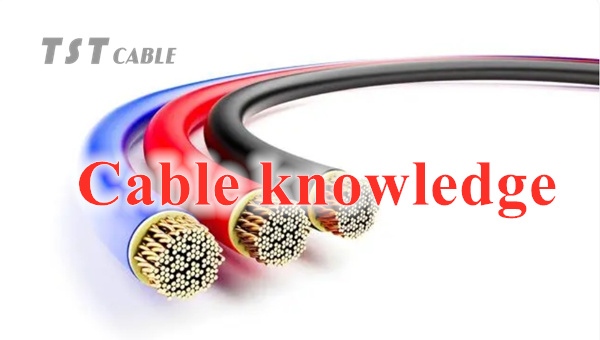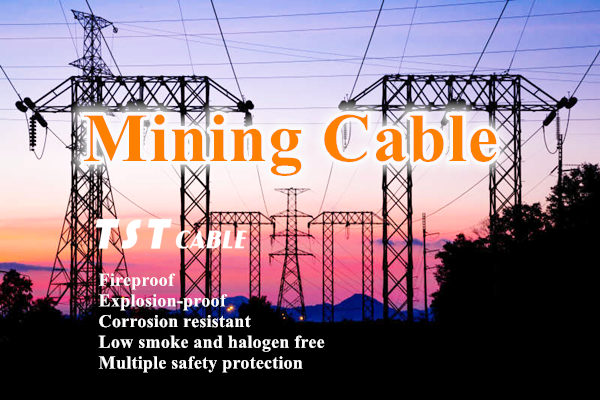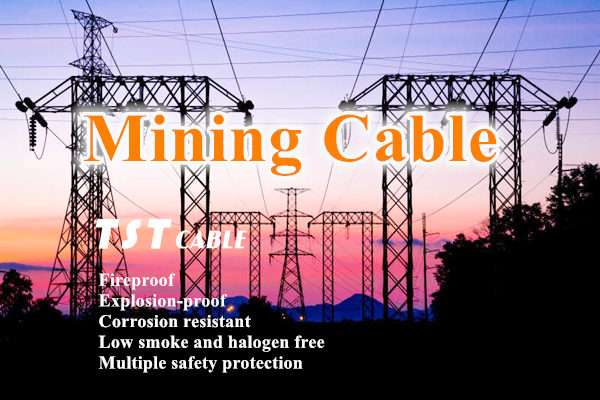Mining, drilling and tunnel cables

Mining cables refer to cables specially designed and manufactured for mining and mine operations. Such cables must have high wear resistance, corrosion resistance, explosion-proof performance and other characteristics to adapt to the complex environment and harsh conditions in mining operations. Mining signal cables are suitable for cables that transmit various electrical signals in mine environment performance. Widely used in various links of coal production for signal transmission, alarm and electromechanical interlocking. Cables often move with equipment and instruments during operation, requiring safe and reliable operation. Therefore, the cable is required to have flexibility and a certain mechanical strength.
The conductive core is made of copper wire with a single wire diameter of 0.2mm to 0.25mm. Rubber insulation is used for insulation, and the core is color-coded or numbered for easy installation and identification. The insulated cores are twisted into cables in a certain order. The sheath is made of chloroprene rubber or similar materials, which are flame-resistant, oil-resistant, and weather-resistant, and have a certain mechanical strength. The length and capacitance of the line should be considered when connecting the cable to equipment and instruments to ensure the speed of signal transmission and reduce line transmission attenuation. The capacitance value of each core on a 1km long cable is less than 0.1μF.
Application fields of mining cables
Coal mining: Applicable to power transmission and signal transmission in coal mines.
Metal mining: Applicable to power and signal transmission in metal mines such as copper and iron mines.
Non-metal mining: Applicable to power and signal transmission in non-metal mines such as graphite and phosphate mines.
Tunnel construction: Applicable to temporary power and signal transmission during tunnel excavation and maintenance.
Main features of mining, drilling and tunnel cables
Wear resistance: Cables in mine operations are often subjected to mechanical friction, so they need to have high wear resistance.
Corrosion resistance: Acids and alkalis in mines can corrode cables, so they need to have good corrosion resistance.
Explosion-proof performance: Considering the possible presence of flammable gases and dust in mine operations, cables need to have explosion-proof performance to ensure safe use.
Temperature resistance: The ambient temperature of the mine varies greatly, and the cable needs to have a wide temperature adaptability.
Electrical performance: Good insulation performance and electrical stability ensure that it can maintain normal working conditions in complex environments.
Mechanical strength: It needs to have sufficient mechanical strength to withstand heavy objects and frequent movement.
Fire resistance: In the event of a fire, the cable should be able to delay the spread of flames and reduce the risk of fire.
Classification of mining, drilling and tunnel cables
Mining cables can be divided into the following categories according to their uses and characteristics:
Mobile rubber sheathed soft cable for mining:
Use: Suitable for mobile equipment in underground mining faces of coal mines.
Features: Good softness, strong wear resistance, good oil resistance and corrosion resistance.
Mining communication cable:
Use: Used for connection between communication equipment in mines.
Features: Good shielding performance to reduce electromagnetic interference.
Mining power cable:
Use: Used for power transmission in mines.
Features: Wear-resistant, oil-resistant, corrosion-resistant, and has good electrical properties.
Mining control cable:
Purpose: used for signal transmission between control devices in mines.
Features: good shielding performance to ensure the accuracy and stability of signal transmission.
Mining signal cable:
Purpose: used for signal transmission in mines.
Features: strong anti-interference ability to ensure clear and reliable signals.
Mining coal mining machine cable:
Purpose: used for large mechanical equipment such as coal mining machines.
Features: extremely high mechanical strength and wear resistance.
Mining towing cable:
Purpose: used for power supply and signal transmission of mobile equipment in mines.
Features: good flexibility, high tensile strength, suitable for frequent movement.
Mining cable manufacturing process
The manufacturing process of mining cables usually includes the following steps:
Conductor production: made of high-purity copper or tinned copper conductors to ensure good conductivity.
Insulation layer: high temperature resistant, oil resistant, corrosion resistant rubber or plastic materials are used as insulation layer.
Shielding layer: for cables that require good shielding performance, a shielding layer will be added outside the insulation layer.
Sheath layer: Wear-resistant, oil-resistant and corrosion-resistant materials are used as the sheath layer to protect the cable from the influence of the external environment.
Special treatment: For cables that require explosion-proof performance, special materials and processes will be used for treatment.
Typical introduction of mining cables
Signal cables for coal mines are suitable for signal transmission in mines and can be used mobile or fixed.
Flame-retardant signal cables for coal mines (now collectively referred to as flame-retardant communication cables for coal mines)
- Product standard: MT818-2011
MHYVR (PUYVR) polyethylene insulated polyvinyl chloride sheathed mining signal cables are used for ordinary signal transmission in mines and can be used mobile.
MHY32 (PUYV39-1) polyethylene insulated steel wire armored polyvinyl chloride sheathed coal mine signal cables are used for signal transmission in horizontal lanes, vertical shafts or inclined shafts.
MHYV (PUYV) polyethylene insulated polyvinyl chloride sheathed coal mine signal cables are used for ordinary signal transmission in mines and are suitable for fixed laying.
MHYVRP polyethylene insulated copper wire braided shielded PVC sheathed signal cable for coal mines, used for signal transmission in places with large electric field interference, the cable is relatively soft.
MHYVP polyethylene insulated PVC sheathed signal cable for coal mines, used for signal transmission in places with large electric field interference, can be used for fixed laying.
Technical standards for mining cables
TB/T2476-1993 Railway signal cable
TB/T3100.1~.5-2004 Railway digital signal cable
Q/JTL051.33-2001 Comprehensive shielded signal cable
Mining cable structure
Mining cable direction box
(1) Seven direction box (HF-7)
There is 1 inlet and 7 outlets, and 7 terminal boards can be installed inside (up to 11 boards can be installed). Each terminal board has 7 terminals, which are used for the connection between the trunk cable and the branch cable.
(2) Four-direction box (HF-4)
It has 1 entrance and 4 exits. 4 6-pin terminal boards can be installed inside. Each terminal board has 7 terminals. It is used for the connection between the trunk cable and the branch cable.
Signal transformer box
The signal transformer box can be used to connect signal equipment, place transformers and other equipment, and realize the relay and direction of cables. It is generally used at the entry signal, exit and shunting signal, and the power supply and receiving end of the track circuit.
Signal transformer boxes are of two types: XB1 and XB2.
XB1 has 4 entry (exit) holes, which can hold 14 terminal boards, each with 2 terminals. XB2 has 5 entry (exit) holes, which can hold 18 terminal boards, each with 2 terminals.
Terminal cable box
The terminal cable box is located at the end of the cable and is used to connect the signal equipment. There are three types of terminal cable boxes: HZ-24, HZ-12, and HZ0.
The HZ-24 cable box has one cable entry hole and one cable exit hole, which can be used for cable relay. A BZ4 small transformer can be placed inside, and 4 6-post terminal boards, i.e. 24 terminals, can be installed to connect with the equipment.
The HZ-12 cable box has only one cable entry hole, i.e. it can only enter but not exit. Two 6-post terminal boards, i.e. 12 terminals, can be installed inside, and can only be used at the end of the cable.
The HZ0 cable box has no terminal board inside, and can only be installed at the sending and receiving end of the track circuit to connect the cable to the rail lead wire.
Cooperate with TST CABLES to customize high-quality mining cables, drilling cables, tunnel cables, and underground cables
TST CABLES mining cables, drilling cables, tunnel cables, and underground cables use new high-strength materials that are wear-resistant and can withstand frequent movement and heavy objects. Special structural design and material selection ensure that the cable is safe and reliable in explosive gas environments. Excellent anti-corrosion performance resists erosion in complex mine environments. Excellent electrical performance, low dielectric constant and high breakdown strength ensure stable transmission of cables in complex environments. Under the deep mines, every inch of cable carries the weight and mission of life. We are well aware of the special needs of mining operations and have carefully created high-quality mining cables to protect the life safety of every miner with excellent performance.
I hope this information will be helpful to you! If you have any further questions about Ethernet cables or need custom made mining cables, drilling cables, tunnel cables, underground cables, you can always email the professional cable engineers at cable manufacturer TST cables (email: lixiangchao@testeck.com, please state your country, your industry application, and your specifications and quantity requirements in the email, we can customize exclusive solutions for you and provide free samples).
Also available in:
English




